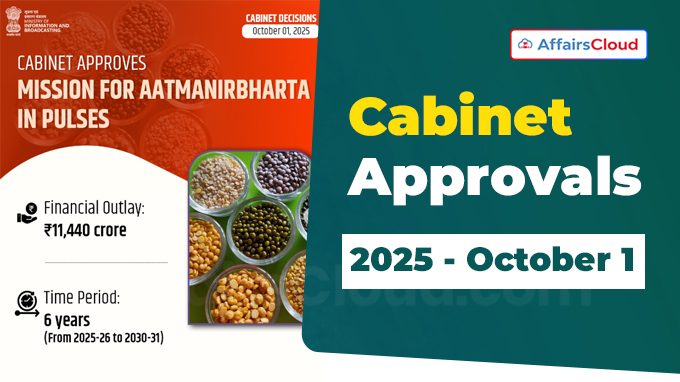In September 2025, the Union Cabinet chaired by Prime Minister (PM) Narendra Modi, has approved the following proposals:
- The Cabinet Committee on Economic Affairs (CCEA) has approved hike in the Minimum Support Prices (MSP) for all mandated 6 rabi crops for the 2026-27 marketing season.
- Mission for Aatmanirbharta in Pulses worth Rs 11,440 crore for period of 6 years (from 2025-26 to 2030-31).
Exam Hints:
- What? Cabinet Approvals
- Approval-1: Hike in MSP of 6 rabi crops for marketing season 2026-27
- Approved by: CCEA
- Crops: Wheat, Barley, Gram, Lentil (Masur), Rapeseed & Mustard, Safflower
- Crops with Highest Cost Production: Wheat (109%); Rapeseed and Mustard (93%); Lentil (89%)
- Highest MSP increase: Safflower (Rs 600 per quintal)
- Aligns with: Union Budget FY19
- Approval-2: Mission for Aatmanirbharta in Pulses
- Purpose: To reduce India’s dependence on import of pulses; conserve foreign exchange reserves
- Total Budget: Rs 11,440 crore
- Time Period: 6 years (from 2025-26 to 2030-31)
- Key Targets: Pulses production from 24.2 MT to 35 MT; Area expansion 242 lakh ha to 310 lakh ha; yield 881 kg/ha to 1,130 kg/ha
- Assured Procurement of Pulses: Tur, Urad and Masur
- Scheme: PM-AASHA
MSP for Rabi Crops for 2026-27 Marketing Season:
Approval : The CCEA approved higher MSP for six key rabi crops(Wheat, Barley, Gram, Lentil, Rapeseed & Mustard, Safflower) to provide better returns to farmers and promote crop diversification.
MSP Rates: Wheat – Rs.2,585/quintal; Barley – Rs.2,150/quintal; Gram – Rs.5,875/quintal, Lentil (Masur) – Rs.7,000/quintal, Rapeseed & Mustard – Rs.6,200/quintal and Safflower- Rs.6,540/quintal
Highest MSP increase: The cabinet has approved the absolute highest increase in MSP for Safflower at Rs 600 per quintal, from existing MSP of Rs 5,940 per quintal (for 2025-26 season) to Rs 6,540 per quintal (206-27 season).
- It is followed by Lentils (masur) at Rs 300 per quintal; Rapeseed and Mustard at Rs 250 per quintal; Chana at Rs 225 per quintal; Barley at Rs170 per quintal; and Wheat at Rs 160 per quintal.
Average Cost of Production: The expected margin over All-India weighted average cost of production is highest for Wheat i.e. 109%; followed by Rapeseed and Mustard (93%); Lentil (89%); Gram (59%); Barley (58%); and Safflower (50%).
Aligns with Union Budget FY19: The MSP hikes are in line with the Government of India (GoI)’s commitment made in Union Budget for Financial Year 2018-19 (FY19) to set MSPs at least 1.5 times the all-India weighted average cost of production.
MSP for all Rabi crops for Marketing Season 2026-27
| Crops | MSP RMS 2026-27 (Rs.per quintal) | MSP RMS 2025-26 (Rs.per quintal) | Increase in MSP (Absolute) (Rs.per quintal) |
|---|---|---|---|
| Wheat | 2585 | 2425 | 160 |
| Barley | 2150 | 1980 | 170 |
| Gram | 5875 | 5650 | 225 |
| Lentil (Masur) | 7000 | 6700 | 300 |
| Rapeseed & Mustard | 6200 | 5950 | 250 |
| Safflower | 6540 | 5940 | 600 |
MSP:Minimum Support Price; RMS: Rabi Marketing Season.
Mission for Aatmanirbharta in Pulses:
Approval: The Cabinet approved a six-year initiative named ‘ Mission for Aatmanirbharta in Pulses’ with a financial outlay of Rs.11,440 crore to achieve self-sufficiency in pulses production.
- This newly approved mission was initially announced by Union Minister Nirmala Sitharaman, Ministry of Finance (MoF) in the Union Budget for FY26.
Key Objectives: To achieve Aatmanirbharta (self-reliance) on pulses, reduce reliance on import and conserve valuable foreign exchange, boost incomes of farmers, and generate significant employment opportunities.
Key Target: The GoI has set the target to increase the production of pulses from 24.2 million tonnes(MT) (in 2024-25) to 35MT (by 2030-31).
Implementation: The National Mission on Pulses will be implemented through cluster-based approach across 416 focused districts of the country.
Key Priority Areas: The mission will focus on research, seed systems, area expansion, assured procurement and price stability.
- Also, the mission will prioritize on developing and disseminating the latest varieties of pulses that are high in productivity, pest-resistant and climate resilient.
Expansion of Pulse Cultivation: The GoI also aims to expand area under pulses cultivation from existing 242 lakh hectares (ha) to 310 lakh ha (by 2030-31).
- Also, GoI aims to achieve yields of 1,130 kilogram (kg) per ha, from 881 kg per ha.
Key Initiatives: The GoI has outlined various key initiatives that will be undertaken under this mission like: about 1,000 new packaging and processing units will be established, with maximum subsidy of Rs 25 lakh available for setting up these processing and packaging units;
- Distribution of 126 lakh quintals of certified seeds to pulse-growing farmers, covering 370 lakh ha by 2030-31;
- Also, 88 lakh seed kits will be distributed free of cost to farmers, to expand the area under pulses by an additional 35 lakh ha by targeting rice fallow areas and other diversifiable lands;
- Multi-location trials will be organised in major-pulse growing states under the mission, ensuring regional suitability.
5-Year Rolling Seed Production Plans: Under this mission, sates will prepare 5-year rolling seed production plans, with breeder seed production monitored by the Indian Council of Agricultural Research (ICAR).
- Central and State agencies will undertake the foundation and certified seed production, which will be tracked through the Seed Authentication, Traceability, & Holistic Inventory (SATHI) portal.
Procurement under PM-AASHA: The key feature of the mission is the assured procurement of tur, urad, and masur under the Price Support Scheme (PSS) of the Pradhan Mantri Annadata Aay Sanrakshan Abhiyan (PM-AASHA).
- The government agencies like National Agricultural Cooperative Marketing Federation of India (NAFED) and National Cooperative Consumers’ Federation of India Limited (NCCF) are entrusted with the responsibility to undertake 100% procurement in participating states for the next 4 years.
Recent Related News:
In September 2025, the Union Cabinet chaired by PM Narendra Modi, approved Rs 1,500 crore incentive scheme, designed to promote recycling capacity for extracting and producing critical minerals from secondary sources.
- This newly approved scheme, part of the National Critical Mineral Mission (NCMM), which is aimed at strengthening India’s domestic capacity and supply chain resilience.





